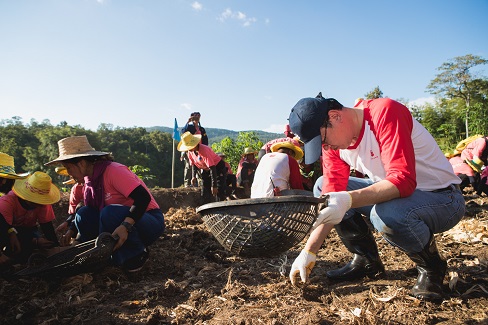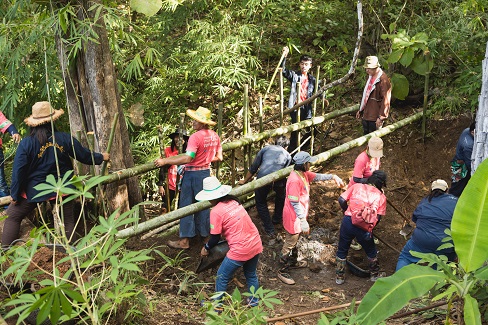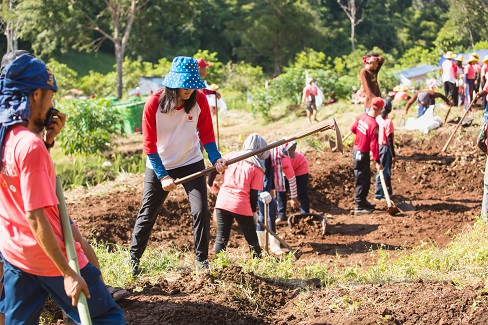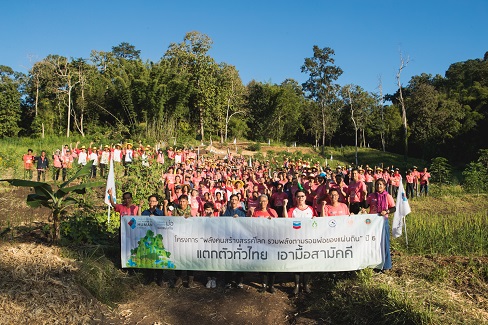press release Chevron and Partners Build Water Catchment Models to Turn the Tide of Deforestation in Nan
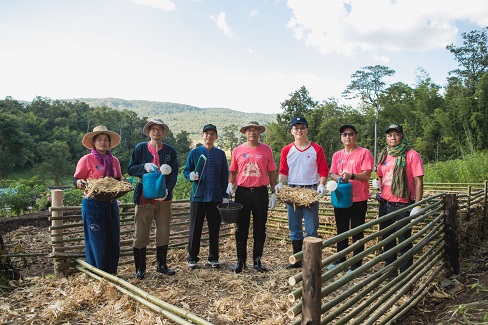
Chevron Thailand Exploration and Production, Ltd., in collaboration with the Institute of Sufficiency Economy, Agri-Nature Foundation and King Mongkut’s Institution of Technology Ladkrabang (KMITL) and partners from all sectors of the society, recently joined hands in the 4th reforestation volunteer activity at Si Nan National Park in Ban Huay Lao, Na Noi district, Nan province.
The activity is the 4th in the series carried out this year, which is the 6th consecutive year of the “The Power of Human Energy: A Journey Inspired by the King”. The activity focused on constructing Loom Kanom Krok water catchment models on highland, regrowing plants, and sharing of knowledge. Among other objectives is to turn one-time forest invaders into forest guardians who would inspire other people to follow the footsteps of His Majesty the Late King Bhumibol Adulyadej in promoting self-sufficiency theory.
“To solve this problem in the long run, we need to dig up water catchment on the highland. This will return greenness to the once depleted forest area. We have to combine the King’s Philosophy, the sufficiency economy theory and local wisdom together and apply them in response to the geo-social environment in the local area. We have to design the area well so that it can hold sufficient water. We have to grow plants that would provide sufficient food and enable the people to live a self-sufficient life. We have to adopt the agri-nature practice. When the villagers live a self-sufficient life, the forest encroachment rate will be reduced. At the same time, the villagers will become forest protectors,” said Wiwat.
Artit Krichphiphat, business support general manager, Chevron Thailand Exploration and Production, Ltd., as the private sector’s leading force, said, “Our goal in the 6th year of this project remains the same. We are expanding the development area under this project from the Pa Sak Watershed to other areas nationwide under the “Collaborative Farming” concept. This activity is inspired by the late King Rama 9’s philosophy. So far this year, we have introduced similar activities in Bangkok, Chanthaburi, Saraburi and now Nan. Each area has unique geo-social environment. We hope that what we have done would become an inspiration for other communities across Thailand.”
The activity attracts approximately 500 people, including Chevron’s employees and executives, as well as volunteers nationwide and the general public who joined the project through Facebook announcements. The event was organized in the 7-rai area owned by Varissara Chanthi (known locally as Karn), one of the villagers living in the national park’s area.
Asst. Prof. Pichate Sowittayasakul, Head of Integrated Technology Operation Center, KMITL, the project’s major academic network, said, “The design concept for constructing water catchments in highland that also corresponds with local geo-social environment is simple. The water catchment must keep the water within the forest. We have to dig up a pond which will serve as a major source of water in the dry season that enables the villagers to grow plants and provide food sources all year round. This will enable human and the forests to cohabit in a harmonious and sustainable manner.”
The Integrated Technology Operation, KMITL (ITOKmitl) has conducted a research on “Thai Social Geographic Design: Monitoring and Assessment for Participatory Local Water Management”. The research is aimed at collecting information about designing and improving land in alignment with the sufficiency economy and the New Theory philosophy in a systematic manner that meets the academic standard. This will enable others to use the information for analysis in terms of economy, society and the environment. The research project, funded by Chevron, lasts for two years, starting from October 2016 until October 2018. Being conducted in three provinces – Lampang, Udon Thani and Tak, it covers 40 samples in over 400 rai. In parallel to the research, reforestation volunteer activities were held within and outside the research areas, including Kanchanaburi, Chiang Mai and Nan provinces. The ITOKmitl plans to present the research results to the public and to apply the discovery and learning from the research to prepare a manual for distribution to other government and private organizations for future use.
During this activity, villagers and volunteers worked together to improve the soil, make fertilizer from corn peels, dig up small waterways in farms, build check dams, manage water supply in the farm, improve existing ponds and construct ridges in the rice fields to enhance ecosystem services and to provide space for food growing. They joined in making bio-extract to improve soil and eliminate soil contamination, plant crops using the ‘3 Forests, 4 Benefits’ principle for sufficient living, grow plants that would help improve soil quality, such as green beans and pumpkins as well as planting flowers to attract more insects to help with pollination.
Bundit Chimchart, Head of Si Nan National Park, the local farming community’s role model, said, “Si Nan National Park was listed as a national park in 1991. In 2007, more areas were added to the national park under the new royal decree. Villager who had occupied the land before the new royal decree was enacted had inadvertently become the encroachers.
“The national park covers over 600,000 rai. Out of this, 12,000 rai have been occupied and used by villagers. To solve this problem, we applied the awareness-raising approach introduced by the late King Bhumibol Adulyadej and successfully turned encroachers to forest guardians. I earlier applied this method to Nam Meed Model with success in Ban Puea Sub-District, Chiang Klang District, Nan. In Nam Meed Village, we have successfully turned 4,000 rai of deforested area out of the total 41,000-rai forest area into watershed forest. Here in Ban Huay Lao Village, I spent 10 months educating the people. Nine have already attended the training, prepared to turn their knowledge into action, and more are set to follow.”
Varissara Chanthi, known as Karn, is one of the participants in this project. She recalled, “Earlier, most of the villagers grew corns because local business people had given them seeds. However, they bought corns from farmers at a very low price and the villagers did not have bargaining power. The more they grew corn, the more debt they had. The villagers also fought with the forest patrol rangers because they had to cut down trees and sell them to earn money to pay debt. Every family had no less than 400,000 baht debt. I myself grew corn on a plot of seven rai and earned around 30,000 baht per year. However, when expenses are deducted from this amount, I earn only 10,000 baht per year.
“When Bundit became the head of the national park, he told us that we had a choice to live a more self-sufficient life. He invited us to observe what others had done in Nam Meed Village. After we came back, I tried but was not successful because we don’t have enough water here. I also found that going at it alone will not be enough so I convinced seven other people to join me. From this group, we invited 26 other villagers to join. The first pond that we dug up was located too high. In July 2018, the Agri-Nature Foundation led a team of 30 volunteers to help us dig waterways across the area. Today, you can see that we now have rice, fruits and vegetables.
“The goal for the seven founders in our group is to clear our debts within five years. From the million-baht debt we had in the beginning, now it is slashed in half,” said Karn.
On 1 December 2018, “The Power of Human Energy: A Journey Inspired by the King” project will announce the project progress to the public. This included the results from the four pilot projects in Bangkok, Chanthaburi, Saraburi and Nan. The announcement will be held at Thanthamturakit, Rama 9 Road. The report will also be featured in “Joh Jai” TV program in which four pioneers in the four pilot projects join the special talk show, sharing their experience from farming under the King’s Philosophy. The TV program will be aired on 1 and 8 December 2018 at 21.40 hrs. on MCOT HD channel.
